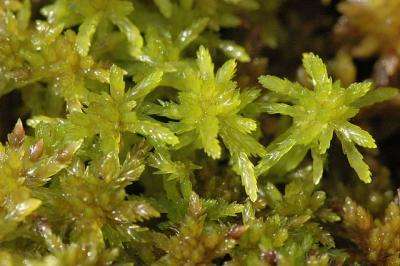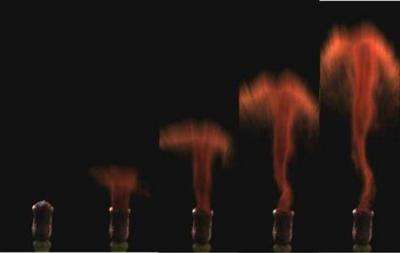July 23, 2010 report
Mosses use 'mushroom clouds' to spread spores (w/ Video)

(PhysOrg.com) -- Scientists in the US have solved the mystery of how peat mosses manage to get their spores high enough to catch the wind, discovering that they produce vortex rings of air, like miniature "mushroom clouds" to boost the spores along -- the first time plants have been shown to be capable of creating such rings.
Sphagnum mosses (also known as peat mosses) are among the commonest plants, with over 285 species. They all use the wind to disperse their spores, but they have a slight problem: they grow flat on the ground where the air is still. They need to get their spores 10 cm into the air to reach the "turbulent boundary layer" where the wind can catch the spores and carry them far away, but until now scientists have not understood how they could do it.
Some species have stalks, but these are only around a centimeter long. The spores are extremely light, which enables them to be blown long distances, but this also means they should decelerate quickly and not be able to reach the required height.

Physicist Dwight Whitaker from Pomona College, California and botanist Joan Edwards from Williams College, Massachusetts, solved the mystery by filming the mosses firing spores from the stalks, using ultra-high speed cameras shooting up to 100,000 frames a second. Their films revealed that a tiny “mushroom cloud” or vortex ring accompanies each firing, and it is the vortex rings that give the spores the extra boost required to reach a good height to catch the wind.
The tip of each stalk contains from 20-250,000 spores in a spherical, waterlogged capsule that dehydrates on sunny days. As it dries out the capsule collapses in on itself to form a cylinder, with the air compressed inside it. When the air pressure reaches a critical point the capsule blows its top off, shooting spores and air upwards to reach the turbulent layer at about 10 cm high. The process takes under one hundredth of a millisecond.
The vortex ring is produced as the air trapped in the capsule explodes outwards. The leading edge pushes against the atmosphere but then rolls back to form a donut-shaped ring. Several animals are known to make vortex rings, but until now no plant has been known to do so. Dolphins produce water vortex rings; jellyfish and squid use water rings to push themselves along, the human heart pushes blood from one chamber to another using vortex rings, and of course humans who smoke can produce smoke rings.
A vortex ring is a very efficient way to move through air or water because it moves as a single unit. The vortex ring formed by the exploding spore capsule enables the spores to keep together as they rise. Without the ring individual spores would slow down and disperse before reaching the turbulent layer, and most would fall back to the ground. Edwards said they had witnessed spore clouds reaching as high as 17 cm, but even the average height of 11 cm gets the spores well into the turbulence.
The findings are published in today’s edition of the journal Science.
More information: Sphagnum Moss Disperses Spores with Vortex Rings, Dwight L. Whitaker and Joan Edwards, Science 23 July 2010: Vol. 329. no. 5990, p. 406, DOI: 10.1126/science.1190179
© 2010 PhysOrg.com
















